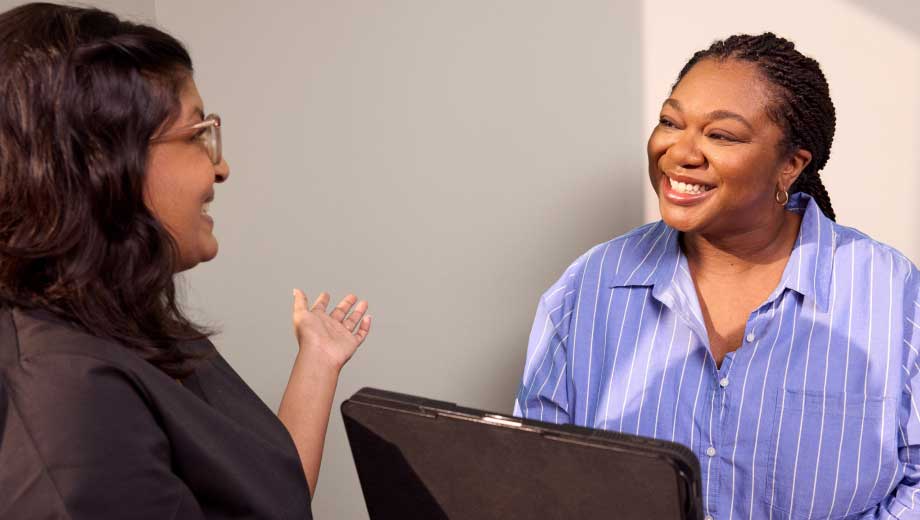It’s an endoscopic procedure that has no scars or incisions. The provider puts an endoscope down the mouth of the patient into the stomach to perform the procedure. The patient is under anesthesia the whole time.

Who’s a good fit for ESG?
If you're ready for a different kind of weight loss, ESG could be a good fit. Find a doctor near you or talk to an Endura Weight Loss Solutions Education Specialist to get started.
Frequently asked questions about ESG
You've got questions. We've got answers.
Unlike a traditional surgical sleeve procedure, ESG is performed without any incisions, and no part of the stomach is removed. It’s similar because it limits the amount of food a person can eat by reducing the size of the stomach.
ESG is an endoscopic procedure that reduces the size of the stomach by stitching the inside, used along with a prescribed diet and exercise program. GLP-1 medications are prescription medicines—available as injections or oral tablets—used along with a reduced-calorie diet and increased physical activity. Depending on the specific product and dosage, they may be indicated for weight management and/or type 2 diabetes.
People usually go home the same day and generally can return to routine daily activity in 2–3 days.2 Follow your doctor’s specific instructions.
ESG can be part of achieving weight loss, but it requires a lasting commitment to losing weight. To keep weight off, it’s important to live a healthy lifestyle, including eating well and staying active.
Each person has different results. In a clinical study, patients lost an average of 13.6% of their total body weight 12 months after undergoing the ESG procedure and following a prescribed diet and exercise program.2
No. In a study people experienced 13.6% average total body weight loss at one year when combined with diet and lifestyle changes.2 These results were achieved without taking GLP-1 medications.
The most common side effects are gastrointestinal symptoms such as nausea, abdominal pain, vomiting, constipation, burping or diarrhea. These symptoms typically resolve within 30–60 days.
All procedures have risk. Talk with your doctor and be sure you understand all the risks before you have any procedure.
ESG is for adults with obesity and a body mass index (BMI) of 30-50kg/ m2 who have not been able to lose weight or maintain weight loss through diet and exercise alone. Talk to a doctor about whether you’re a good candidate.
Your doctor will ask you about your medical history and perform a physical exam to decide if OverStitch is right for you. At the time of your procedure, the doctor may detect internal issues that prevent you from receiving OverStitch. For example, stomach ulcers or inflammation in the stomach may impact device placement.
You should not receive OverStitch if you: have a large hiatal hernia; have a history of bleeding in your stomach or food pipe; have a history of eating disorders; are pregnant; have bleeding disorders or are on blood thinners.
Your provider can work with you one-on-one on to discuss coverage or financing options for your procedure.
What about cost and insurance?
Your provider can work with you one-on-one to discuss coverage or financing options for your procedure.

You're not alone in your weight loss journey
Sometimes a little help is all it takes to start the changes you've always wanted. See how ESG helped others get closer to their goals.
- Mike
- Laurie
- Emily
- Scott
Let's get started
Learn more about ESG or find a doctor to get started.
*Individual weight loss may vary.
Results in other cases may vary. In a study, patients with class 1 (BMI 30 to <35 kg/m²) or class 2 (BMI 35 to <40 kg/m²) obesity who underwent ESG in conjunction with prescribed diet and exercise counseling achieved an average of 13.6% total body weight loss at year one.
‡ All trademarks are the property of their respective owners. Any use of third-party trademarks, logos, or brand names is for identification purposes only and does not imply endorsement or affiliation.
1. For the OverStitch Endoscopic Suturing System you need to follow a healthy diet and exercise program to lose weight. You may not lose weight if you do not adopt healthy habits. Your doctor’s clinical team, including dieticians, nutritionists and/or exercise trainers, should help you on your weight loss journey.
2. Abu Dayyeh BK, Bazerbachi F, Vargas EJ, et al. Endoscopic sleeve gastroplasty for treatment of class 1 and 2 obesity (MERIT): A prospective, multicentre, randomised trial. Lancet. 2022;400:441–451.
Important OverStitch Endoscopic Suturing System Safety Information
ESG is performed using a suturing device called OverStitch. Learn about the risks of the OverStitch Endoscopic Suturing System & OverStitch NXT
Endoscopic Suturing System (“OverStitch”) for bariatric surgery:
Talk with your doctor to fully understand all the risks and benefits associated with using this device. Ask your doctor whether this device is right for you.
Indications for Use:
OverStitch is for adult patients with obesity with BMI between 30-50 kg/m2. OverStitch can reduce the size of the stomach by stitching the inside. It can also fix the stomach outlet from previous bypass surgery.
When OverStitch is used to help with weight loss, you need to follow a healthy diet and exercise program. You may not lose weight if you do not adopt healthy habits.
Contraindications:
Your doctor will ask you about your medical history and perform a physical exam to decide if OverStitch is right for you. At the time of your procedure, the doctor may detect internal issues that prevent you from receiving OverStitch. For example, stomach ulcers or inflammation in the stomach may impact device placement.
You should not receive OverStitch if you: have a large hiatal hernia; have a history of bleeding in your stomach or food pipe; have a history of eating disorders; are pregnant; have bleeding disorders or are on blood thinners.
Warnings:
Talk to your doctor if you develop major, continued upper abdominal or back pain with difficulty breathing at any time after getting OverStitch.
OverStitch contains nickel. Nickel may cause an allergic reaction in people with nickel sensitivity.
Potential Risks:
Breathing any foreign object or substance such as food, saliva, or stomach contents into your lungs; Intestine blockage; Switching to a different type of surgery; Nausea, vomiting, dehydration; Bleeding; Infection; Swelling, redness, and pain in tissues caused by injury or damage; Damage to or a hole through the tissue around the stomach, food pipe or surrounding organs; Unintended transfer of fluid or gas from one area of the body to another; Pain; Feeling pins and needles; Buildup of fluid around the stomach; Air leaking from the lungs; Difficulty breathing; Narrowing or tightening in the stomach; Wound opening; Death
MRI Safety Information:
OverStitch can be MRI scanned under certain conditions. Scanning under other conditions may result in injury or device malfunction. Inform your doctor or MRI technician of the device before undergoing an MRI scan. This allows them to take any needed precautions.
